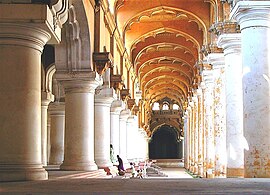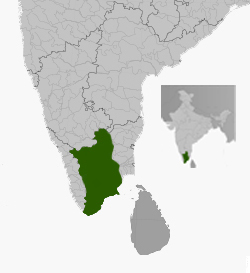Madurai Nayak Dynasty
| Madurai Nayak dynasty | |||||
|
|||||
|
Approximate extent of the Madurai Nayak Kingdom, circa 1570.
|
|||||
| Capital |
Madurai (1529–1616) Tiruchirapalli |
||||
| Languages | Telugu, Tamil | ||||
| Government | Governors, then Monarchy | ||||
| History | |||||
| • | Established | 1529 | |||
| • | Disestablished | 1736 | |||
| Preceding States | Succeeding States
|
Breakaway States
|
| Kings and Queen Regents of Madurai Nayak Dynasty |
|
|---|---|
| Part of History of Tamil Nadu | |
 |
|
| Madurai Nayak rulers | |
| Viswanatha Nayak | 1529–1563 |
| Kumara Krishnappa Nayak | 1563–1573 |
| Joint Rulers Group I | 1573–1595 |
| Joint Rulers Group II | 1595–1602 |
| Muttu Krishnappa Nayak | 1602–1609 |
| Muttu Virappa Nayak | 1609–1623 |
| Tirumalai Nayak | 1623–1659 |
| Muthu Alakadri Nayak | 1659–1662 |
| Chokkanatha Nayak | 1662–1682 |
| Rangakrishna Muthu Virappa Nayak | 1682–1689 |
| Rani Mangammal‡ | 1689–1704 |
| Vijaya Ranga Chokkanatha Nayak | 1704–1731 |
| Queen Meenakshi‡ | 1731–1736 |
| ‡ Regent Queens | |
| Capitals | |
| Madurai | 1529–1616 |
| Tiruchirapalli | 1616–1634 |
| Madurai | 1634–1665 |
| Tiruchirapalli | 1665–1736 |
| Major forts | |
| Madurai 72 Bastion Fort | |
| Tiruchirapalli Rock Fort | |
| Dindigul Fort | |
| Thirunelvelli Fort | |
| other Military forts | |
| Namakkal Fort | |
| Sankagiri Fort | |
| Attur Fort | |
| Palaces | |
| Thirumalai Nayak Mahal, Madurai | |
| Chokkanatha Nayak Palace a.k.a. Durbar Hall, Tiruchirapalli | |
| Rani Mangammal Tamukkam palace Madurai | |
Tiruchirapalli
(1616–1634)
Madurai
(1634–1695)
Tiruchirapalli
(1695-1716)
Madurai
(1716–1736)
The Madurai Nayaks were rulers from around 1529 until 1736, of a region comprising most of modern-day Tamil Nadu, India, with Madurai as their capital. The Nayak reign was an era noted for its achievement in arts, cultural and administrative reforms, revitalization of temples previously ransacked by the Delhi Sultans, and inauguration of a unique architectural style.
The dynasty consisted of 13 rulers, of whom 9 were kings, 2 were queens, and 2 were joint-kings. The most notable of these were the king, Thirumalai Naicker, and the queen, Rani Mangammal. Foreign trade was conducted mainly with the Dutch and the Portuguese, as the British and the French had not yet made inroads in the region.
Several theories were proposed for the origin of Madurai Nayaks. Among them, the most widely accepted theories are they were Telugu warriors sent to colonise Tamil country by Vijayanagar Kings.
Acharya Tirumalai Ramachandra, famous historian of early 20th century after examining various marriage alliances and origin theories described that Madurai Nayaks belong to Kamma caste.
Kamma Nayaks formed the bulwark of the Vijayanagara army and were appointed as governors in many areas of Tamil Nadu, to protect the Hindu dharma in dhakahinapatha and they successfully played their part in which their role in the protection of the last great Hindu kingdom of India was significant.
The Kaifyat of Karnata-Kotikam Kings which was written in the early 19th century describes that Madurai Nayaks belonged to the Balija social group.
Balijas were mobilised politically by Vijayanagara emperor Sri Krishna Deva Raya. Afterwards they went to colonise the Tamil country in the 15th and 16th centuries, establishing the Nayaka chieftaincies.
By this time, the term "Balija" also came to include the some other castes like Boyas, Gollas, Gavaras and other castes.
...
Wikipedia

